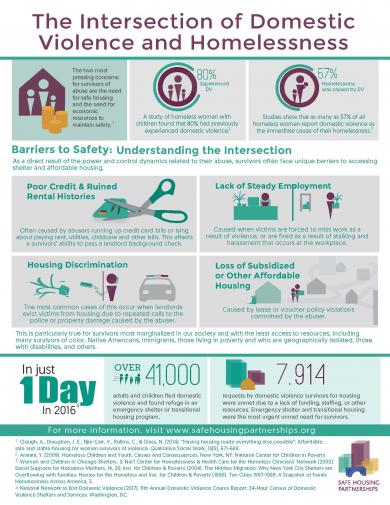Understanding the Intersections
Domestic and sexual violence is a leading cause of homelessness for women and children, and the need for safe and affordable housing is one of the most pressing concerns for survivors of violence and abuse. Many survivors face unique barriers to accessing shelter and affordable housing due to the power and control dynamics involved in these types of abuse and the economic and trauma impacts that result. These barriers are often exacerbated for those most marginalized in our society and with the least access to resources, including many survivors of color, Native Americans, immigrants, those living in poverty and in geographic isolation, formerly incarcerated survivors, and survivors with disabilities. In addition, systemic factors such as institutional discrimination and the lack of affordable housing in communities create further challenges for many survivors. At the same time, housing programs can provide critical services for survivors and are often a key component in helping survivors find safety and stability.
"In just one day in 2016, over 41,000 adults and children fleeing domestic violence found refuge in an emergency shelter or transitional housing program."
from Domestic Violence Counts: 11th Annual Census Report
"In a study of residents in domestic violence shelters across the country, 84% reported that they needed help finding affordable housing."
from Meeting Survivors' Needs: A Multi-State Study of Domestic Violence Shelter Experiences
"Among mothers with children experiencing homelessness, more than 80% had previously experienced domestic violence."
from Homeless Children and Youth: Causes and Consequences
"In one Florida study, 78.3% of homeless women in the study had been subjected to rape, physical assault, and/or stalking at some point in their lifetimes."
from The Experience of Violence in the Lives of Homeless Women: A Research Report
"In a 2006 study of rape crisis centers and legal aid providers, 58% of respondents stated that at least one tenant reported sexual assault by a landlord during the survey period."
from National Survey of Advocates on Sexual Violence, Housing, and Violence Against Women Act
"In a national survey of victim service providers, one third of providers reported that up to 20% of victims and survivors struggle to find or keep housing because of sexual violence."
from Housing and Sexual Violence: Overview of National Survey: January 2010
"Thirty-eight percent of respondents to a national survey reported receiving reports of landlord sexual assault; in these cases, 79% of women reported that their landlords refused to repair locks, supply heat, hot water, or make the space 'safe.'"
from Landlord Sexual Assault and Rape of Tenants: Survey Findings and Advocacy Approaches via Housing, Homelessness, and Sexual Violence Statistics handout from NSAC 2011
"A range of factors increase homeless women's risk of adult sexual victimization...[they] coexist, interact with, and exacerbate each other over time, creating a complex and distinctive context for each woman."
from "No Safe Place: Sexual Assault in the Lives of Homeless Women"
